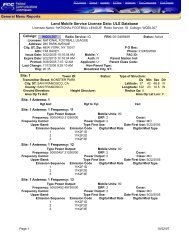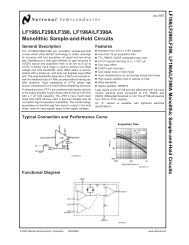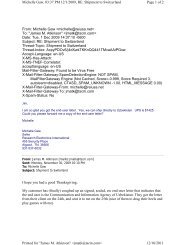Create successful ePaper yourself
Turn your PDF publications into a flip-book with our unique Google optimized e-Paper software.
7.VPN<br />
What is a Virtual Private Network?<br />
Company networks are for the most part physical: all computer resources are physically articulated<br />
around a local network in a same place. Using such a network means having to be physically close to<br />
the access points that we wish to reach. This is a major restriction when information must transit over<br />
long distances.<br />
A network extension is <strong>of</strong>ten done by using Internet resources. It is however not technologically<br />
possible to trust machines relaying information on the Internet. To make sure that the network remains<br />
private, even if it follows public paths, there are s<strong>of</strong>tware solutions using secure protocols, essentially.<br />
As the communicating entities are not assembled in a same location, the network is said to be “virtual”.<br />
So a VPN is more than a well-defined technical solution.<br />
What services for a VPN?<br />
Using secure services such as SSH, is within the elaboration <strong>of</strong> a VPN. Generally speaking, though, it<br />
is actually necessary to secure not just one service, but all services, whatever they may be.<br />
So we directly secure packets <strong>of</strong> common communication protocols (IP and protocols <strong>of</strong> associated<br />
data transport). The security <strong>of</strong> a VPN means controlling the following points:<br />
IPSec<br />
– confidentiality <strong>of</strong> data (cryptography)<br />
– integrity <strong>of</strong> data (checksums)<br />
– authentication <strong>of</strong> entities (cryptographic signatures)<br />
IPSec can secure Ipv4 and Ipv6 packets. IPSec is based on security rules called SA, as in <strong>Security</strong><br />
Associations. These rules are grouped in an SPD (<strong>Security</strong> Policy Database).<br />
IPSec is flexible and modular. It is implemented in different ways according to the needs <strong>of</strong> the<br />
association rules. It guarantees the integrity <strong>of</strong> a packet (AH method based on MD5 or SHA-1) and its<br />
confidentiality through encrypting (ESP method based on RSA), or both. The negotiation protocol <strong>of</strong><br />
keys for the cryptographic aspect <strong>of</strong> IPSec is called IKE.<br />
As the entries in SPD are static, IPSec is an efficient protocol for communications between machines<br />
with fixed IPs (to link two local networks <strong>of</strong> companies via Internet through two gateways, for example).<br />
There are two communication modes for IPSec: transport and tunnel. In transport zone, only<br />
transported data is secured (IPSec headers are placed just after the IP header). In tunnel mode, IPSec<br />
generally takes charge <strong>of</strong> the IP header as data to cover (IPSec is placed before the IP header, and<br />
adds another one behind it).<br />
The <strong>Hack</strong>ademy DMP -205/209- SYSDREAM
















